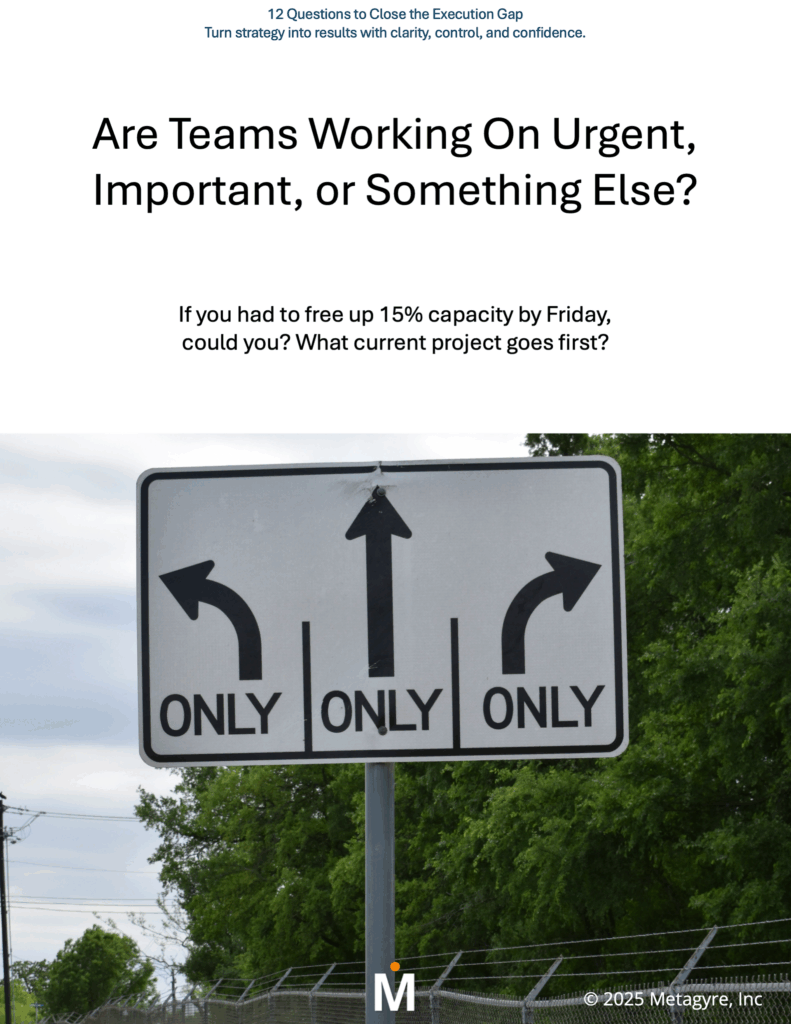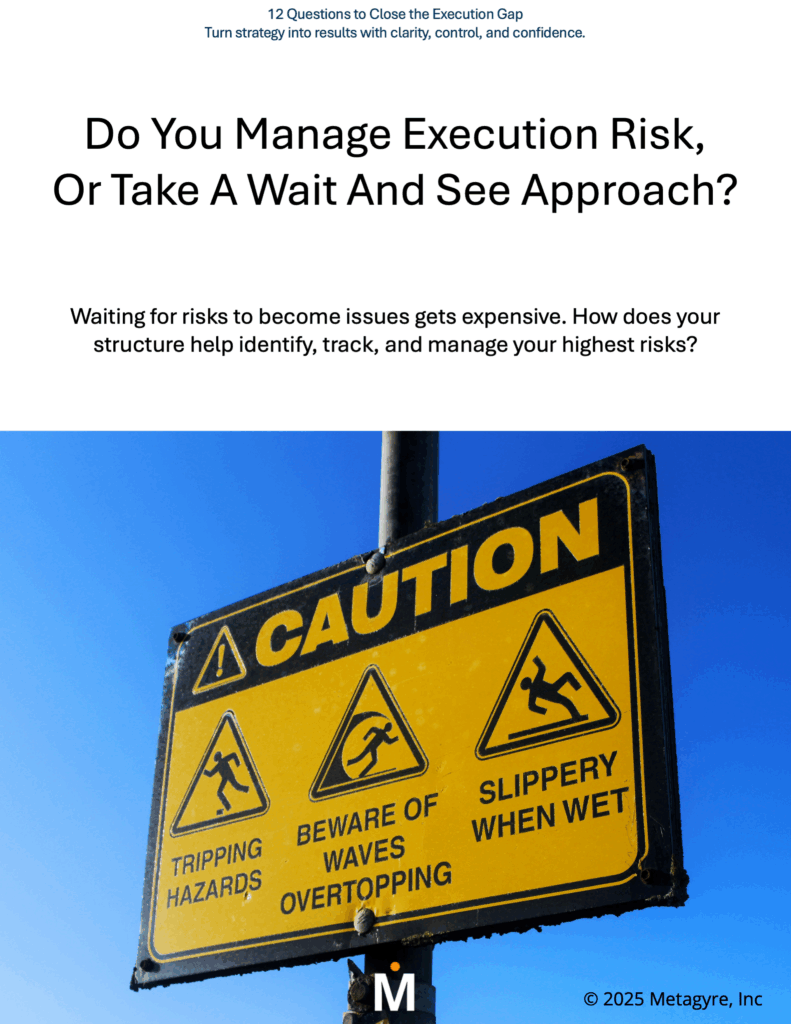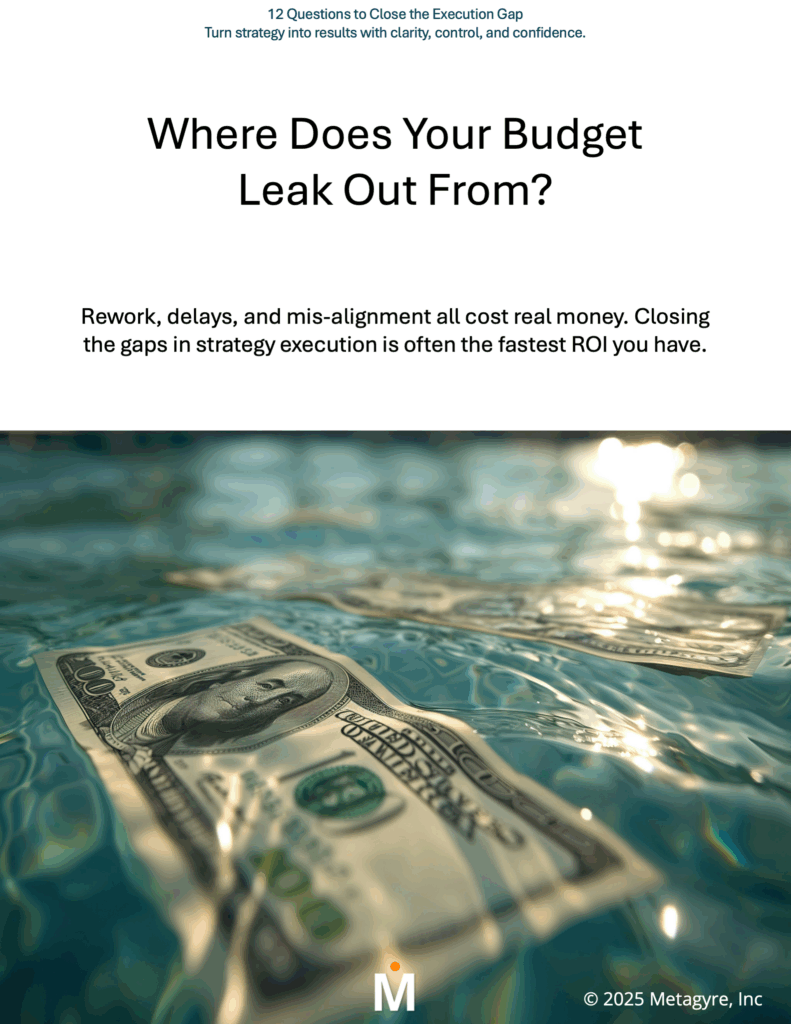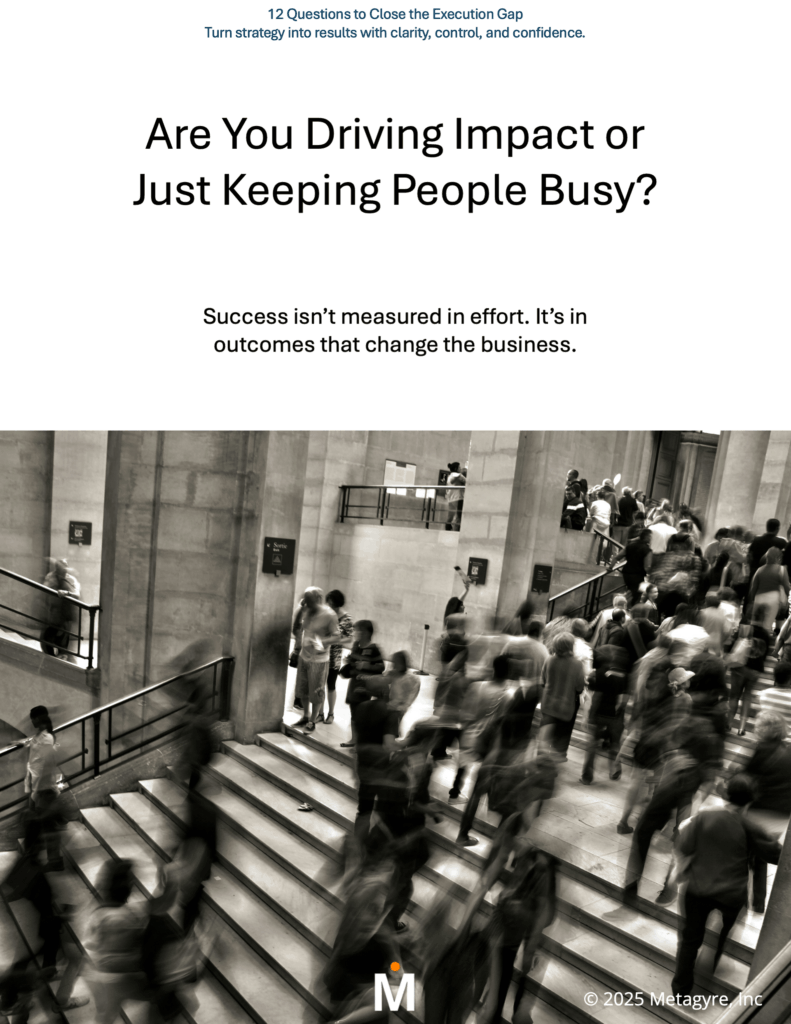Most strategies don’t fail in the boardroom. They fail in the handoff to execution, when visibility blurs, priorities multiply, and decisions slow to a crawl. The execution gap isn’t about intent or effort. Strategy execution is held back by outdated structure and poor methods.
These next 12 questions are designed to help you recognize and close the strategy execution gaps in your organization’s. Each one is a simple prompt, drawn from real programs where we turned strategy into results with clarity, control, and confidence.
No. 1 Enterprise Visibility
When you say you have “visibility,” is it a forward view or just a polished status that is looking back? Move from accepting rearview reporting to preventing tomorrow’s problems. Set the expectation of forward-looking insight that ensures no blind spots, no surprises.
How To Start:
Replace “green” status summaries with a forward risk look: “What could slip next, why, and the trigger to watch.” Ask teams to show the delta since last week (what changed and why), not just a static snapshot.
One thing to try this week:
Have your PMs add a single update to every status: “Next 2 risks you’re watching and their early warning signals.” Consider what blind spot bit you last quarter? How would an early signal have exposed it?

No. 2 Total Clarity
Do you get straight consistent answers or status that’s been “rounded” to avoid hard conversations?
Leaders don’t have time for spin. Total clarity means truth, accountability, and a line of sight to what’s next.
How to start:
Begin simply, standardize on:
🟢 Green = on track;
🟡 Yellow = concern needs leadership help;
🔴 Red = at risk to miss outcomes.
No fuzzy definitions. For every Yellow/Red, require a decision ask and a deadline.
One thing to try this week:

Use these two questions high-performing executive leaders have shared from their battles to win at strategy execution. Ask initiative owners:
- “What is your plan to get back to green?”
- “What do you need from me by Friday to turn this?”
Then, ask yourself, who in your organization is always first to have these hard conversations? Reward them!
No. 3 Prioritize Demand
Are your teams working on the initiatives that truly move the business forward, or are they drowning in important-looking work that won’t advance your strategy? It’s easy to measure effort. What matters is focusing energy on the few execution things that actually shift outcomes.
How to start:
Kill or pause two “nice to have” projects for every “must win” initiative you green-light.
Tie all projects to one business metric (revenue, margin, customer experience, risk). If you can’t, pause it.
One thing to try this week:
Run a 30-minute “keep/kill/pause” session on your active project portfolio.

What are you hanging on to and why? If you had to free 15% capacity by Friday, what goes first?
No. 4 Start Executing on Strategy
Is your strategy showing up in daily work or still stuck in slide decks and on leaders’ whiteboards?
dIf vision is never translated into actions and accountabilities, transformation never ha
ens. Sometimes you have to prime the pump to start execution delivery.
How to start:
“Make Execution Real For The Team”: make sure every strategic initiative lands in a specific backlog, owner, and work breakdown.
Create guiding principles (guardrails) leaders will enforce and teams can count on to start their work plans flowing.
One thing to try this week:

For each strategic priority, write one guiding principle: “If we’re serious, we will stop ___, and start ___, so that teams can plan on ___.” Is there a strategic line item hasn’t landed with any force yet? Is it still Important?
No. 5 Accelerate Decisions
Do trade-offs get made early with confidence or only after delays have already taxed your momentum?
Slow decisions don’t just waste time, they sap energy and stall strategy execution. The speed of alignment often sets the speed of progress.
How to start:
Pre-wire big decisions by using the employing the Alternative Effect and running a paper route: 1:1s with key stakeholders. Use curiosity to surface objections, improvements, and agreement. Shift from the room debate to ratification.
Add a weekly “decision checkpoint” with a visible list: decision, owner, deadline, status.
One thing to try this week:

Pick one stalled decision and pre-wire it with your paper route; walk into the meeting ready to ratify, not debate. Examine where decisions languish in your org and who actually has the pen? What risks are holding them back?
No. 6 Adaptive Planning
Does your planning process build momentum or kill it before execution even starts?
Rigid, bloated plans leave little room for flexibility and collapse under their own weight. Adaptive planning aligns fast, shifts as needed, and keeps things moving fluidly with the business.
How to start:
Set your goals and establish guardrails. Establish target dates than build individual detailed plans for each mobilization in rolling 4–6 week waves, conducting weekly reviews.
Fix WIP: limit concurrent “in-flight” activities per team to avoid thrash and overwhelm. Look for the resource constraint and reduce the friction on them.

One thing to try this week:
Set a WIP limit for one team (e.g., max 3 active work-streams). Watch cycle time improve. Consider what’s the smallest planning window you can commit to without losing control?
No. 7 Structured Agility
Do your initiatives adapt with predictable control or lurch from crisis to crisis under the banner of “being agile”?
Agility without structure is chaos. The strongest enterprises move quickly and adapt with discipline.
How to start:
Define “fast” decision rights: which calls can teams make without escalation.
Observe a dress rehearsal for a mobilization cut sheet on any high-risk change. Moving fast includes planning for a clean entry, exit, and if needed reentry. Attendance shows your support and confidence if they need to make the call.

One thing to try this week:
Pick one area to grant clearer autonomy: “You don’t need approval for X if Y and Z are true.” Consider where smaller work packages and stronger guardrails will allow your team to gain speed, stay in control and make better decisions on their own.
No. 8 Proactive Risk Identification
Are risks flagged when you should act or only after they become expensive issues? Most “surprises” aren’t surprises just signals we didn’t hear.
Great systems surface risk before they sting.
How to start:
Add a 15-minute weekly “risk management” huddle: what changed, what’s likely to slip, what’s our trigger?
Tie each “high-impact”, “likely to occur” risk to a leading indicator you can watch (e.g., scope change count, burndown trend, vendor response time) and build a plan to mitigate its consequences.
One thing to try this week:

Capture “top 3 likely slips” on the RAID Log. Name the trigger for each and keep communicating the risk until it passes. Think about what early signal would have saved you the most last year?
No. 9 Flawless Execution, Zero Waste
How much of your budget shows up as results and how much disappears into rework, delays, and idle WIP? Every enterprise leaks value through poor execution.
Closing those gaps is often the fastest ROI you have and will to payout longterm dividends.
How to start:
Track one: rework rate, scope changes, wait time between handoffs, constrained resource, or blocked tasks by owner. Establish a value per unit that can tie back to a budget.
One thing to try this week:
“Single Item Batches” rule: create smaller mobilization scope and gain control over risk, losses, and delays. Less will yield more in this case.

Run one small-batch mobilization with explicit cut sheet criteria. Compare costs, customer disruption, and rework.
Where’s your biggest leak: angry customers, wait times, constrained resources, or over-scoped changes?
Want help quantifying the cost to fix execution? This strategy execution cost article walks through it.
No. 10 Make Outcomes Visible
Are projects delivering what the business actually needs or just finishing and moving on?
Outcomes matter. Those that change the business trajectory really matter.
Project Portfolio management (PPM) is where you align the work with desired outcomes. Project and Program Delivery (PPD) is where the transformation happens. Visibility is achieved through a structure that integrates both.
How to start:
Tie each initiative to one business outcome with a target value and by when.
Replace “percent complete” with “milestones that matter” and measured impact.

One thing to try this week:
Add a simple impact line to your dashboard: “We expect ___ by ___; current trend: ___.” Owners present follow-up with actual value realized?
Which project is “on track” but not moving a business metric?
No. 11 Balance Strategy and Department Needs
Are teams stretched too thin between enterprise priorities and their daily work?
You need both. If strategy wins and the day job loses, work jams. If operations always wins out and strategy loses, nothing changes.
How to start:
Set a simple 60/40 split for each team: 60% effort on essential local/BAU, 40% on enterprise priorities.
Write the split on the team “wall”. Any exception must list who + why + until when. If enterprise vs. local conflicts, the PPM governance owner makes the call within 24 hours, and it goes on the wall.
One thing to try this week:

Identify one team or individual who is the most constrained resource? Do what it takes to optimize their utilization and off-load non-essential tasks. Track their time to see when they’re in balance again. Where is your 60/40 split out of whack.
No. 12 Radical Transparency
Do people give the real status or a version that won’t ruffle feathers? Are risks raised early, or only after they become fires?
Ruthless transparency isn’t finger-pointing; it’s saying what’s true, showing what’s next, and owning the trade-offs.
How to start:
Publicly praise anyone who escalate root cause.
Add a simple root-cause line to every Yellow/Red: problem → root cause → fix → owner → due date.
Make it visible on the team board and in the weekly recap. Track the trend moving away from its root cause.

One thing to try this week:
Pick one root cause slowing a key initiative (scope churn, defect spikes, missed handoffs, resource gaps). Track and add it as a public metric to your dashboard and report progress weekly.
Conclusion
High-performing executive leaders don’t rely on luck. Instead they use these 12 powerful concepts to drive execution and turn their strategy into results.
- Enterprise Visibility
- Total Clarity
- Prioritize Demand
- Start Executing on Strategy
- Accelerate Decisions
- Structured Agility
- Adaptive Planning
- Proactive Risk Identification
- Flawless Execution, Zero Waste
- Make Outcomes Visible
- Balance Strategy and Department Needs
- Radical Transparency
Grab your copy of the 12 Questions to Close the Execution Gap: Turn strategy into results with clarity, control, and confidence. Share it with your leadership teams and experience high performance strategy execution by closing the gaps in your organization.




